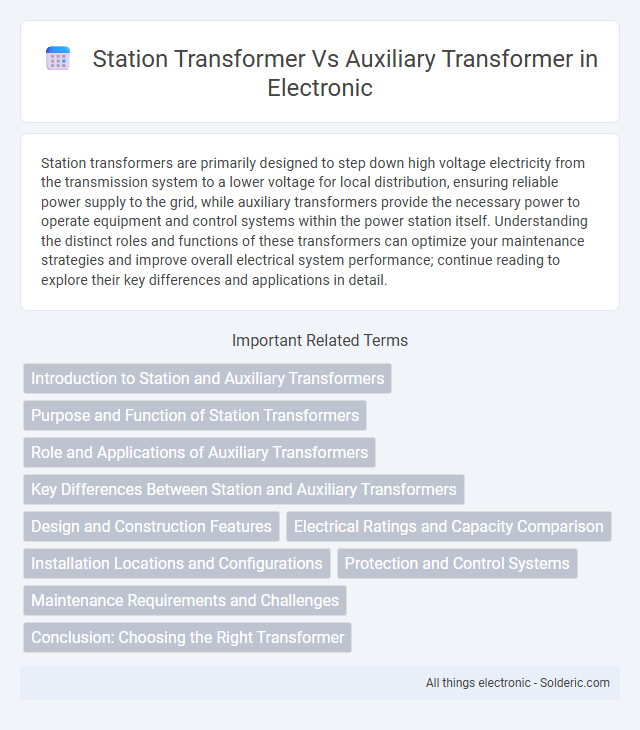Station transformers are primarily designed to step down high voltage electricity from the transmission system to a lower voltage for local distribution, ensuring reliable power supply to the grid, while auxiliary transformers provide the necessary power to operate equipment and control systems within the power station itself. Understanding the distinct roles and functions of these transformers can optimize your maintenance strategies and improve overall electrical system performance; continue reading to explore their key differences and applications in detail.
Comparison Table
| Feature | Station Transformer | Auxiliary Transformer |
|---|---|---|
| Purpose | Supplies power to the substation equipment and control systems | Provides power to auxiliary services like lighting, fans, and control panels |
| Location | Installed within the substation premises | Located near power generating stations or substations |
| Voltage Rating | Medium voltage to low voltage (e.g., 11kV/415V) | Varies, often lower than station transformers |
| Load Type | Feeds critical substation loads and protection circuits | Feeds non-critical auxiliary loads |
| Capacity | Generally higher capacity to handle essential equipment | Lower capacity, designed for less critical loads |
| Importance | Crucial for substation operation and safety | Supports comfort and operational convenience |
Introduction to Station and Auxiliary Transformers
Station transformers primarily step down high voltage power from the transmission system to usable levels for the substation's own equipment, ensuring stable operation of protection and control devices. Auxiliary transformers supply lower voltage requirements for auxiliary equipment within industrial plants or power stations, such as motors, lighting, and control circuits. Understanding the distinct roles of these transformers helps optimize Your electrical system's efficiency and reliability.
Purpose and Function of Station Transformers
Station transformers primarily supply power to auxiliary equipment within substations, ensuring continuous operation of control, protection, and communication devices. Auxiliary transformers serve to step down voltage for secondary systems such as lighting, heating, and small machinery within industrial plants or power stations. Understanding the purpose of station transformers helps you optimize substation reliability and efficiency by maintaining essential power to critical auxiliary functions.
Role and Applications of Auxiliary Transformers
Auxiliary transformers supply essential power to auxiliary equipment such as control devices, lighting, and protection systems within substations and power plants. These transformers ensure continuous operation of critical components by stepping down voltage from the station transformer to usable levels for auxiliary loads. Your electrical infrastructure relies on auxiliary transformers for reliable voltage regulation and system stability during operation.
Key Differences Between Station and Auxiliary Transformers
Station transformers primarily handle high voltage step-down to supply power for the entire substation's operational equipment, while auxiliary transformers provide lower voltage power for internal substation control systems and auxiliary loads. Station transformers feature higher ratings and robust insulation to manage bulk power, whereas auxiliary transformers are smaller with specialized designs for stable, low-voltage output. Understanding these distinctions helps optimize your substation's design and ensures reliable power distribution efficiency.
Design and Construction Features
Station transformers are engineered for high-capacity power distribution within substations, featuring robust insulation, larger cores, and enhanced cooling systems to handle heavy load demands and improve reliability. Auxiliary transformers possess compact designs optimized for supplying lower voltage power to station equipment, incorporating specialized windings and protection mechanisms to ensure stable operation for control and auxiliary devices. Both transformer types employ durable materials and precise winding techniques, but station transformers prioritize high voltage endurance while auxiliary transformers focus on efficiency and safety in powering secondary circuits.
Electrical Ratings and Capacity Comparison
Station transformers typically have higher electrical ratings and capacity, designed to handle large power loads for distributing electricity across the grid. Auxiliary transformers possess lower ratings, intended primarily to supply power to internal equipment and control systems within substations or power plants. Your choice depends on the required capacity, with station transformers supporting bulk transmission and auxiliary transformers managing operational power needs.
Installation Locations and Configurations
Station transformers are typically installed outdoors at power substations to step down high-voltage transmission levels for operational use, often configured as pad-mounted or outdoor-distribution transformers. Auxiliary transformers are commonly located inside power plants or industrial facilities to supply lower voltage power for control systems and auxiliary equipment, usually configured as oil-immersed or dry-type transformers within controlled environments. Your choice depends on the required installation location and the specific configuration needed to support the operational setup.
Protection and Control Systems
Station transformers and auxiliary transformers play distinct roles in power system protection and control systems. Station transformers supply power to control and protection devices, ensuring continuous operation during faults, while auxiliary transformers provide isolated and stable power specifically for control circuitry and emergency systems. Your overall protection strategy benefits from coordinated settings that leverage the unique voltage levels and isolation characteristics of both transformer types to maintain system reliability.
Maintenance Requirements and Challenges
Station transformers require regular inspection of cooling systems and oil quality to prevent overheating and insulation failure, while auxiliary transformers demand frequent checks on tap changers and load conditions due to their role in supplying power to control and protection systems. Maintenance challenges for station transformers include managing high-voltage insulation degradation and ensuring reliable cooling, whereas auxiliary transformers face issues related to their typically smaller size, compact design, and susceptibility to voltage fluctuations. Both types necessitate proactive monitoring using online diagnostics and infrared thermography to detect early signs of faults and prevent outages.
Conclusion: Choosing the Right Transformer
Choosing the right transformer depends on your facility's specific power distribution needs, with station transformers primarily designed to handle high voltage levels and supply main power to substations. Auxiliary transformers serve smaller loads, providing lower voltage for equipment like lighting, control systems, and auxiliary motors. Evaluating load requirements and voltage levels ensures optimal efficiency and reliability in your electrical system.
station transformer vs auxiliary transformer Infographic

 solderic.com
solderic.com